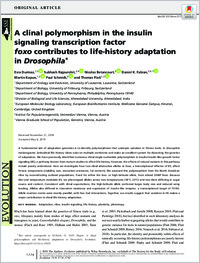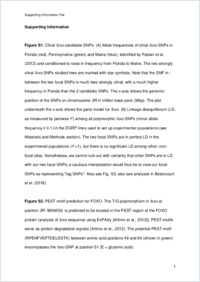A clinal polymorphism in the insulin signaling transcription factor foxo contributes to life-history adaptation in Drosophila*
- Durmaz, Esra Department of Ecology and EvolutionUniversity of Lausanne Lausanne Switzerland - Department of BiologyUniversity of Fribourg Fribourg Switzerland
- Rajpurohit, Subhash Department of BiologyUniversity of Pennsylvania Philadelphia Pennsylvania 19140 - Division of Biological and Life SciencesAhmedabad University Ahmedabad India
- Betancourt, Nicolas Department of BiologyUniversity of Pennsylvania Philadelphia Pennsylvania 19140
- Fabian, Daniel K. European Molecular Biology LaboratoryEuropean Bioinformatics Institute Wellcome Genome Campus, Hinxton Cambridge United Kingdom - Institut für PopulationsgenetikVetmeduni Vienna Vienna Austria - Vienna Graduate School of Population, Genetics Vienna Austria
- Kapun, Martin Department of Ecology and EvolutionUniversity of Lausanne Lausanne Switzerland - Department of BiologyUniversity of Fribourg Fribourg Switzerland
- Schmidt, Paul Department of BiologyUniversity of Pennsylvania Philadelphia Pennsylvania 19140
- Flatt, Thomas Department of Ecology and EvolutionUniversity of Lausanne Lausanne Switzerland - Department of BiologyUniversity of Fribourg Fribourg Switzerland
-
2019
Published in:
- Evolution. - 2019, vol. 73, no. 9, p. 1774–1792
English
A fundamental aim of adaptation genomics is to identify polymorphisms that underpin variation in fitness traits. In Drosophila melanogaster, latitudinal life‐history clines exist on multiple continents and make an excellent system for dissecting the genetics of adaptation. We have previously identified numerous clinal single‐nucleotide polymorphism in insulin/insulin‐like growth factor signaling (IIS), a pathway known from mutant studies to affect life history. However, the effects of natural variants in this pathway remain poorly understood. Here we investigate how two clinal alternative alleles at foxo, a transcriptional effector of IIS, affect fitness components (viability, size, starvation resistance, fat content). We assessed this polymorphism from the North American cline by reconstituting outbred populations, fixed for either the low‐ or high‐latitude allele, from inbred DGRP lines. Because diet and temperature modulate IIS, we phenotyped alleles across two temperatures (18°C, 25°C) and two diets differing in sugar source and content. Consistent with clinal expectations, the high‐ latitude allele conferred larger body size and reduced wing loading. Alleles also differed in starvation resistance and expression of insulin‐like receptor, a transcriptional target of FOXO. Allelic reaction norms were mostly parallel, with few GxE interactions. Together, our results suggest that variation in IIS makes a major contribution to clinal life‐history adaptation.
- Faculty
- Faculté des sciences et de médecine
- Department
- Département de Biologie
- Language
-
- English
- Classification
- Biological sciences
- License
-
License undefined
- Identifiers
-
- RERO DOC 327364
- DOI 10.1111/evo.13759
- Persistent URL
- https://folia.unifr.ch/unifr/documents/307966
Other files
Statistics
Document views: 171
File downloads:
- pdf: 118
- Supplementary material: 112

